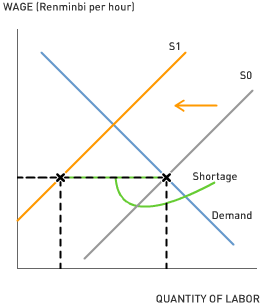China's Demographic Dilemma
by Brandon Fuller
As growing numbers of elderly Chinese workers retire from the workplace to the mahjong table, China's pension system and labor markets are in for disruption.
Aplia Econ Blog readers know about the difficulties facing public pension systems in aging OECD countries (archived entry here). But the falling ratio of active Chinese workers to retirees highlights another dilemma: labor shortages and rising wages in China's labor-intensive manufacturing sector. A few months ago, Aplia Econ Blog examined a New York Times article detailing the demand-side contribution to rising wages in the Chinese labor market (archived entry here). A recent Times article explores the effects of an aging Chinese population on the supply side of the labor market.

1. China adopted a planned birth policy in 1979. The "one-child policy" made it very financially unattractive for parents to have more than one child. The planned birth policy significantly lowered the fertility rate (the average number of child births per woman of child-bearing age) in China's urban areas. How do China's population policies help to explain the looming pension and labor market dilemmas?
2. The article mentions that China's household registration system restricts internal migration. The planned birth policy had a much smaller impact on fertility rates in China's rural areas. As a result, many young workers reside in the countryside where average wages are below urban levels. How would abolition of the household registration system affect urban labor markets? Might relaxing internal migration restrictions (short of total abolition) relieve the pressure on wages in China's urban industrial centers?
3. Urban prosperity in China continues to widen the income gap between urban and rural Chinese. In the absence of any internal migration reforms, what will happen to income inequality as the ratio of workers to retirees continues to fall in urban areas?
4. According to the article, how will rising wages in China's urban areas affect industries in Vietnam, Bangladesh, and India? What will happen to America's yawning trade deficit with China if the aging urban population causes wages in China's manufacturing industries to rise?
Topics: China, Labor markets, Aging populations, Trade, Income inequality
Aplia Econ Blog readers know about the difficulties facing public pension systems in aging OECD countries (archived entry here). But the falling ratio of active Chinese workers to retirees highlights another dilemma: labor shortages and rising wages in China's labor-intensive manufacturing sector. A few months ago, Aplia Econ Blog examined a New York Times article detailing the demand-side contribution to rising wages in the Chinese labor market (archived entry here). A recent Times article explores the effects of an aging Chinese population on the supply side of the labor market.

1. China adopted a planned birth policy in 1979. The "one-child policy" made it very financially unattractive for parents to have more than one child. The planned birth policy significantly lowered the fertility rate (the average number of child births per woman of child-bearing age) in China's urban areas. How do China's population policies help to explain the looming pension and labor market dilemmas?
2. The article mentions that China's household registration system restricts internal migration. The planned birth policy had a much smaller impact on fertility rates in China's rural areas. As a result, many young workers reside in the countryside where average wages are below urban levels. How would abolition of the household registration system affect urban labor markets? Might relaxing internal migration restrictions (short of total abolition) relieve the pressure on wages in China's urban industrial centers?
3. Urban prosperity in China continues to widen the income gap between urban and rural Chinese. In the absence of any internal migration reforms, what will happen to income inequality as the ratio of workers to retirees continues to fall in urban areas?
4. According to the article, how will rising wages in China's urban areas affect industries in Vietnam, Bangladesh, and India? What will happen to America's yawning trade deficit with China if the aging urban population causes wages in China's manufacturing industries to rise?
Topics: China, Labor markets, Aging populations, Trade, Income inequality
Labels: Labor, Supply and Demand



0 Comments:
Post a Comment
<< Home